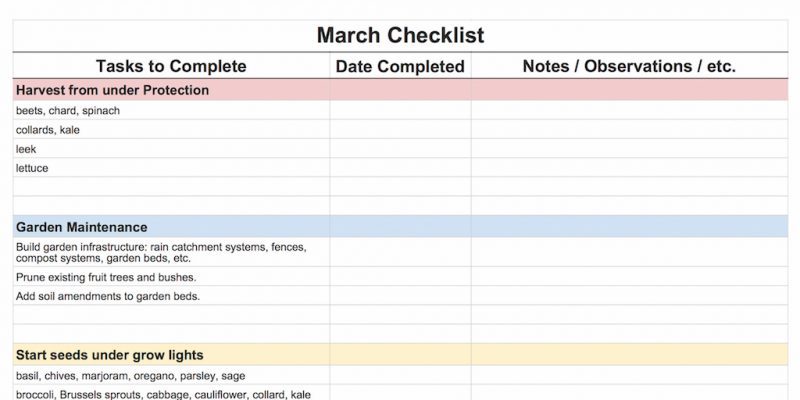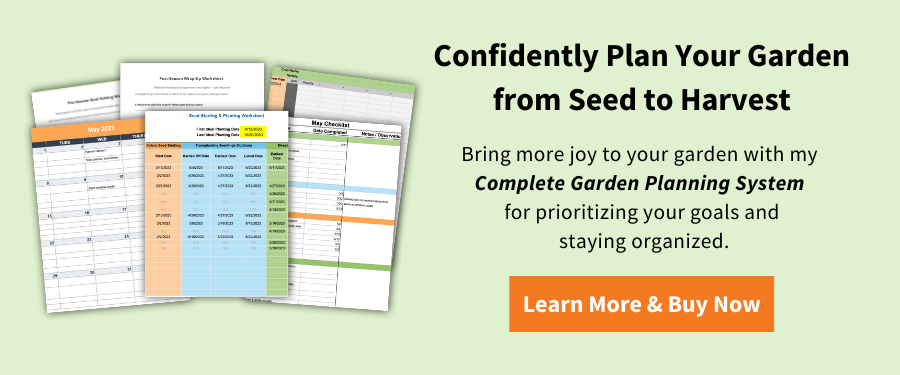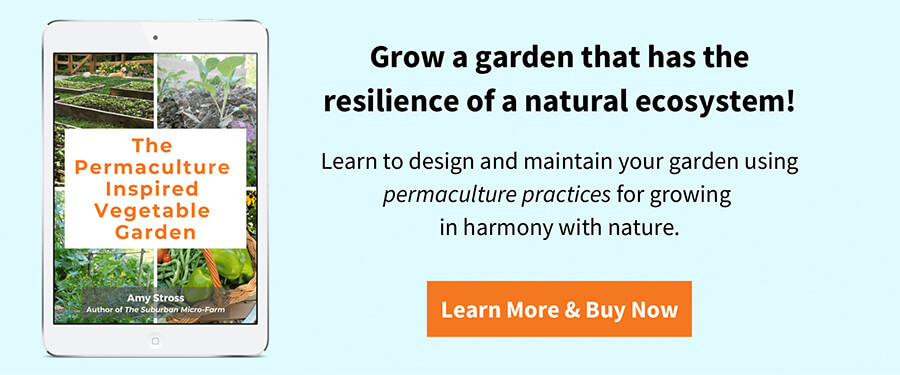Four Garden Planning Tools You Need This Year
Are visions of bountiful gardens dancing in your head? Here are four essential garden planning tools to help you kick off your best garden season yet.


This page may contain affiliate links. Please read my disclosure for more info.
My Journey to Creating the Garden Planning Tools
I was sorely lacking in a streamlined approach my first few gardening seasons. Without records, I didn’t know when things should be, or had been, planted. I lacked a plan other than “I want a garden.”
When I got outside, I had no idea how to prioritize my time. I was the poster child of an ADD gardener: “Oh, look at this!” And, ohhh, I want to work on this!” I was dizzy from turning in circles!
I didn’t feel connected to my garden because I was caught up in the pressure of deciding what to work on. This is what entrepreneur Tim Ferriss calls “decision fatigue”.
I longed for a garden planning process that would keep all of my gardening resources and tasks in one place. Wouldn’t it be great if I could eliminate all of the random scraps of notes and the slew of web pages bookmarked on my computer?
After a few years of experimenting, I created my own Micro-Farm Organization Process. It has worked wonders to keep me organized and help me grow my best garden. In this article, I share this process with you, including how I use monthly checklists, calendars, and spreadsheets.
These tools will help define your priorities so you can enjoy your time in the garden. Checklists remove the mental energy of decision-making.
The Essential Garden Planning Tools
Here are the tools I created for my own Micro-Farm Organization Process:
- Seed Starting & Planting Worksheet
- Monthly Checklists
- Monthly Calendars
- Harvest Log
I’ll show you how I take advantage of each of these tools in the garden planning steps below.
Garden Planning Steps and How to Put the Garden Planning Tools to Work
#1: Choose What to Plant
This is probably one of the most difficult decisions!
Having trouble deciding? Make a list of what your household likes to eat. You can be more adventurous in the future as you become more comfortable with your garden.
See my article Want to Be a Micro-Farmer? 6 Tips for Success and 6 Things Not To Do.
Gardeners learn by trowel and error.” ~Author Unknown


#2: Plan Your Seed-Starting and Planting Schedule
The next thing to do is figure out what to plant when, especially when it comes to starting seeds indoors (See my step-by-step seedstarting guide).
For example, to determine the date to start tomato seeds, first identify your spring frost date and count backward on the calendar. This website is helpful to find the spring frost date for your local area.
Tomatoes are started about six weeks before the spring frost date. Counting backward from my frost date of April 13th, I can determine that I should start tomato seeds indoors around March 2nd.
A Spreadsheet for Your Thoughts
The first garden planning tool I created was a spreadsheet to help me organize my seed-starting and planting schedules.
On the spreadsheet I wrote the name of each crop I wanted to grow. Then, based on my spring frost date, I calculated the date for each crop of when to start seeds indoors, when to transplant outdoors, and when to direct-sow the seeds outside. I wrote all of this information on the spreadsheet.
I even calculated when to sow seeds in succession if I wanted a fall crop.
Does this sound like a lot of work? I’m not gonna lie, it certainly is. But it’s the perfect activity to work on while you wait on the arrival of your seeds and gardening supplies!
If you’d rather let the hard work be done for you, I’ve got you covered!
Grow a garden that’s both productive and manageable with my Complete Garden Planning System, which includes practical tools for planning your season from seed to harvest.
#3: Create Monthly Checklists
Another one of my garden planning tools that is a lifesaver is the monthly checklists. I use them to keep track of garden tasks and when to do them throughout the year. I like to set these up before the garden season is in full swing.
The checklists help me visualize what’s in store for any given month, and help me remember once-a-year tasks that are easily forgotten, such as pruning the fruit trees or berry bushes. I’ll add things like, ‘Set up indoor seed starting system’ on my January checklist, or ‘Sow peas’ to my March checklist.
Checklists are a great way to help you use your time efficiently.
After I’ve decided what to plant and have completed my Seed Starting & Planting spreadsheet, then I fill in my monthly checklists with harvesting, planting, and sowing information. The first column of the spreadsheet lists the tasks and in the second column I add the date completed.
I treat the checklist like a to-do list that orders tasks by priority.
Harvesting should be the number one priority. Even if you don’t get the chance to plant anything else, at least you can reap what you’ve already taken the time to sow.
The Monthly Checklists are another one of the bonus garden planning tools that you’ll be able to download with your purchase of The Suburban Micro-Farm. You’ll get my sample checklists to give you an idea of how I do it.


Keeping Notes: Observe and Reflect
Learn to be an observer in all seasons. Every single day, your garden has something new and wonderful to show you.” ~ Author Unknown
One feature that I added to my own monthly checklists is a ‘Notes’ section. I take my monthly checklists to the garden with me so I can cross items off as I complete them.
I can jot down important information—dates for when I notice certain pests, actual planting dates, and when I added soil amendments, for example. Having the checklist in the garden encourages me to be more observant, as if I were a curious scientist conducting a study:
“Kale leaves are especially chewed up today from cabbageworms, Sept. 1st. Note for next year: Research beneficial insects that prey on cabbageworms and what I should plant with kale to attract beneficials.”
These notes and reflections will help you in subsequent years to become more in tune with the challenges and features of your particular landscape.
#4: Create Monthly Calendars
Once you’ve filled out your Seed Starting & Planting Spreadsheet and generated your Monthly Checklists, it’s time to figure out how you’re going to balance your busy “real life” stuff with all of these exciting garden goals.
That’s where another one of my garden planning tools, the Monthly Calendar, comes in. I’m a visual person, and using a monthly calendar helps me to see all of a month’s tasks alongside my real-life schedule. This helps me make time for all of the seed starting, planting, and other garden activities.
A wall calendar will do the trick.
Here’s an example of my January Garden Guide.
Add Garden To-Do Items to your Monthly Calendars
Take information from your Seed Starting & Planting Spreadsheet and write it on the calendar. For example, on March 2nd, I might write, “Start tomato seeds indoors,” and on May 3, I might write, “Transplant tomatoes to the garden.” Do this for tasks on your Monthly Checklists as well.

 Add Personal Life Requirements to the Monthly Calendars
Add Personal Life Requirements to the Monthly Calendars
When I write my real-life commitments on the calendar, such as my work hours, ‘Grandma’s Birthday Party,’ ‘Oscar’s Karate Match,’ or ‘Family Vacation,’ I can see what days and times are available to schedule in garden tasks.
Rather than purchasing a wall calendar each year—which didn’t fit in my three-ring garden notebook—I created a printable monthly calendar. You’ll be able to download it as one of the four bonus garden planning tools that comes with your purchase of The Suburban Micro-Farm.
When I schedule garden tasks alongside ‘real life’ appointments, I’m more likely to make time for them and consider them a priority. I’m also more likely to use my garden time efficiently.
Learn about my 15-minutes-a-day garden in my article 5 Myths about Starting a Micro Homestead.
Would you like to grow more food with less effort? Check out my mini guide, The Permaculture Inspired Vegetable Garden.
#5: Create a Harvest Log
The harvest log keeps track of the crops you harvest, the date(s) of harvest, and the quantity. I have a digital scale that I use to weigh and record my harvests when I bring them inside.
I’ve kept harvest records for the last eight years, and I’m so glad.
I’ve been able to see what my best and least performing crops are, and track accurate harvest windows for each based on the specific conditions of my yard.
Knowing my true harvest windows has helped me plan vacations around certain harvests so we don’t miss out.
As you might guess, the Harvest Log is the final of four bonus garden planning tools you get to download with the purchase of The Suburban Micro-Farm.
The Harvest Log is one of my favorite resources because who doesn’t like to have evidence of all they yield from their hard work?
So that’s the Micro-Farm Organization Process.
There are a lot of things to think about when planning a garden and getting it underway in the springtime, but these garden planning tools will help you have your best garden season yet!
How do you stay organized and keep records for your gardening and micro-farming adventures?
READ NEXT:









